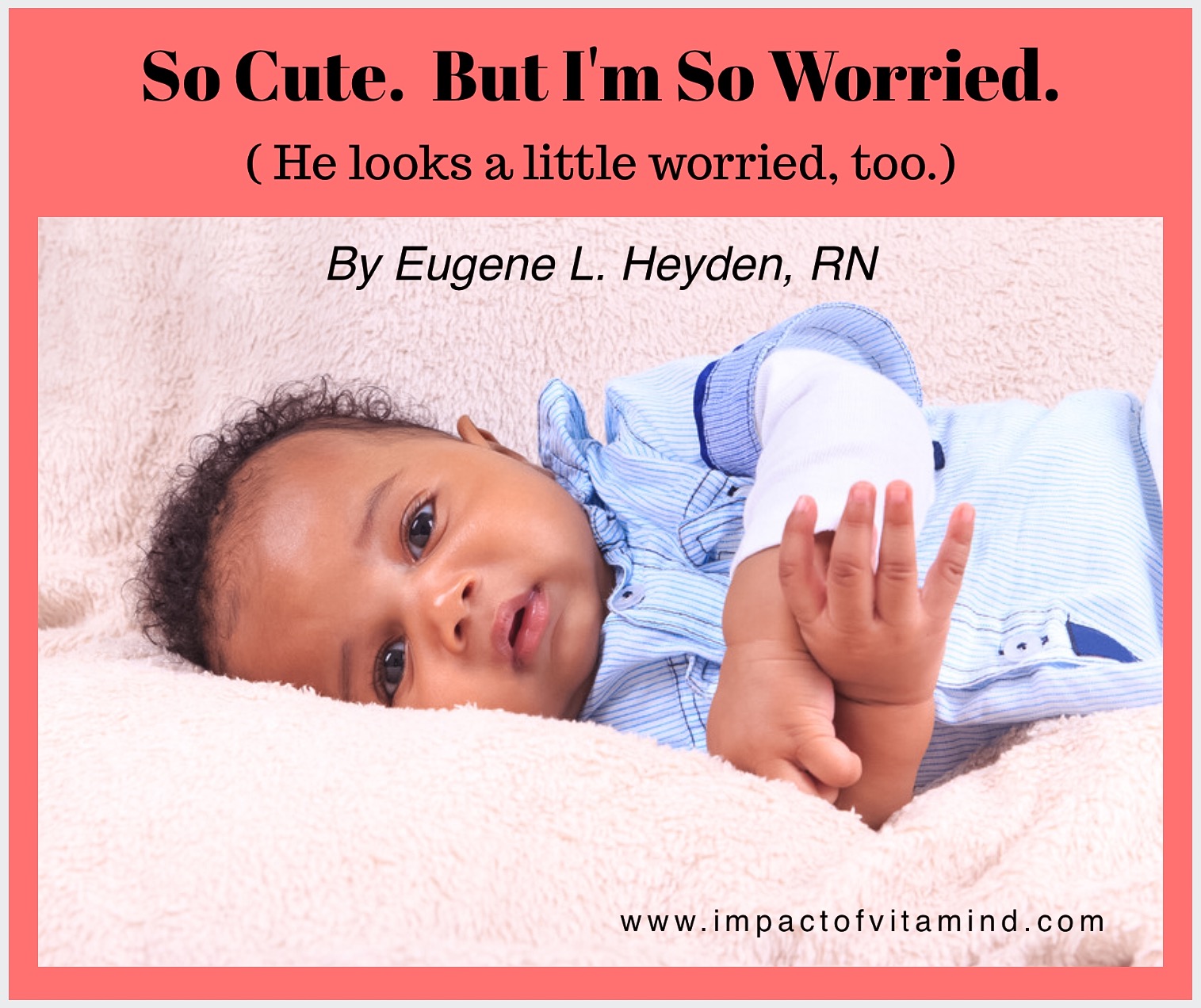Last update: 05/05/25
By Eugene L. Heyden, RN
There’s a real story here. I don’t like it at all. It is a sad story—and not just a sad story; it’s a tragedy.
One by one, too many of our precious African American babies (and other babies with dark skin) are off to a rough start in life. And I know why. I will tell you. Unfortunately, this story is one of those never-ending stories, unless we do something about it. I have something in mind.
Likely, this never-ending story starts before birth.
“It is well known that vitamin D deficiency is prevalent among pregnant women and pregnant women have significantly lower levels of 25(OH)D than nonpregnant control women. Approximately two in three pregnant women in the United States have suboptimal vitamin D status, with an even higher prevalence among black and Mexican-American women.” (Lerchbaum and Obermayer-Pietsch, 2012, emphasis added)
Vitamin D deficiency during pregnancy is fraught with danger. This danger threatens women of all races and ethnicities. But for mothers with darker skin, vitamin D deficiency is a whole lot easier to come by, making the African American pregnancy (among others), and the unborn baby involved, at heightened risk for some very bad things. I would say fetal loss is a bad thing. I would say preeclampsia is a bad thing. I would say gestational diabetes is a bad thing. I would say fetal growth restriction is a bad thing. To all this, I will add an increase in the risk of maternal death.
The bad things mentioned above are unquestionably associated with maternal vitamin D deficiency. And the crazy thing: this is a problem so easy to detect and so easy to resolve.
“Vitamin D deficiency is often clinically unrecognized, however laboratory measurements are easy to perform, and treatment of vitamin D deficiency is inexpensive.” (Grundermann and von Versen-Höynck, 2011)
Vitamin D during pregnancy plays several vital roles. It is not just a minor nutrient; it is an essential hormone. In the context of pregnancy, this vitamin—this hormone—performs numerous beneficial actions, many of which support a successful pregnancy. It must be present in sufficient amounts. Vitamin D helps shield both the baby and the placenta from infection. It allows the blood vessels in the placenta to develop properly, decreasing the chances of placental insufficiency and a serious medical condition called preeclampsia. Vitamin D has so much to offer. For many unborn babies, it is the gift of life. However, for many of the unborn, maternal vitamin D deficiency is a death sentence. As heartbreaking as this is, it gets worse—there is a tragedy within a tragedy. This death sentence is disproportionately carried out.
“In 2005, black mothers were 2.3 times as likely as white mothers to experience an intrauterine fetal death or death of their infant.” (Bodnar and Simhan, 2010)
In the research paper quoted directly above, Bodnar and Simhan present a compelling argument that maternal vitamin D deficiency contributes to the disparity in pregnancy complications and outcomes between Black and White individuals, with individuals with darker skin facing a higher risk of maternal death and complications.
The reasons vitamin D deficiency is more common in the African American community are clear. 1) Darker skin—developed in ancient times to help populations endure greater sunlight exposure—requires 10 to 50 times more sun exposure than lighter skin to produce an equivalent amount of vitamin D (Bodnar and Simhan, 2010). Who among us takes the time to produce thousands of IUs (International Units) of vitamin D daily through sun exposure? 2) Diet is also a significant factor. Many foods rich in vitamin D—such as seafood, reindeer meat, and walrus blubber—are often substituted with fast or convenience foods that have limited vitamin D content. Reliance on convenience foods is more common in the African American community. 3) Dairy avoidance also contributes to vitamin D deficiency. Our society fortifies milk and dairy products with vitamin D, making them significant sources. However, many Black individuals are lactose intolerant and cannot benefit from this valuable source. 4) Absent or insufficient supplementation with vitamin D is more common among Black individuals than among White individuals. 5) Obesity rates are higher among African Americans compared to Whites. Obesity is a risk factor for vitamin D deficiency because fat cells serve as storage depots for vitamin D. The more fat cells an individual has, the more likely vitamin D will be stored rather than becoming available for immediate use by the mother and her developing baby. The following should be of no surprise:
“Not surprisingly, there is a striking black–white disparity in the prevalence of vitamin D deficiency.” (Bodnar and Simhan, 2010)
Considering all the roles vitamin D plays during pregnancy, is it any wonder that so many Black babies start life at a disadvantage, both at birth and beyond?
“Compared to white women, black women are at 1.5- to 2.5-fold greater risk of delivering a preterm birth, or very preterm birth, as well as a term low birth weight infant.
“Black infants are four times as likely as whites to have been exposed to in-utero vitamin D deficiency. They also die at a rate more than twice that of their white counterparts, and experience more frequent morbidity.” (Bodnar and Simhan, 2010)
Are you getting the picture? On average, Black babies are disproportionately set up for a bad start in life. Vitamin D deficiency plays a significant role. So, what is being done about this? Practically nothing. The professional rationale for doing “practically nothing” goes something like this: “We need further studies to elucidate the issues more clearly before we can arrive at a consensus on what steps to take in the future.” There is no sense of urgency or serious action plan to eliminate vitamin D deficiency during pregnancy—whether Black, Brown, or White. And yet we wonder why the rates of preventable deaths and complications remain largely unchanged, decade after decade.
Now, I can’t say for certain whether the little guy up there was born prematurely or not, but I do know he made it out alive. Many do not. Let’s give the little guy a break and assume that Mom was vitamin D sufficient during her pregnancy, giving him a great start in life. If that’s true, it would be nice. However, even if this is the case, vitamin D sufficiency likely hasn’t been maintained, even if he was sufficient at birth.
Separated at birth from its mother and her circulating supply of vitamin D, the newborn baby has about an 8-week supply of vitamin D available, even in the best circumstances (Dawodu and Wagner, 2007). Therefore, if the baby is nursing, Mom should take a substantial amount of vitamin D (or produce a lot through sun exposure), or her breast milk will be deficient. Studies indicate that it takes at least 2,000 IU—better yet, 4,000 IU to 6,000 IU of daily vitamin intake—for any significant amount of vitamin D to appear in breast milk (Hollis and Waggoner, 2004; Hollis et al., 2015). Acknowledging that achieving the above level of supplementation is unlikely, experts strongly recommend that nursing infants receive vitamin D supplements. Without supplementation, rickets—a condition characterized by weak and deformed bones—may develop.
Surprisingly, in the USA today, rickets is more likely to occur in exclusively breastfed African American infants. Fortunately, if an African American baby is on formula, sufficient vitamin D is included to help prevent rickets, at least for a time. Rickets can develop beyond infancy, even during adolescence (Wagner et al., 2008). A child who complains of muscle pain, which often occurs in rickets or a related condition known as osteomalacia, should be evaluated for vitamin D deficiency. Indeed, every child—whether Black, White, or somewhere in between—should be assessed for vitamin D deficiency; however, our African American children are clearly at a higher risk for rickets and osteomalacia compared to children with lighter skin.
According to FamiliesUSA.org, compared to ethnic groups with lighter skin, African American babies have twice the rate of infant mortality and are twice as likely to die from SIDS (Sudden Infant Death Syndrome). With respect to SIDS, “Bone pathology in sudden infant death syndrome (SIDS) was investigated by British researchers, who found 87% of the SIDS babies less than one year of age showed histopathological [tissue pathology] of rickets.” (Post and Ernst, 2013) FYI: Rickets is almost exclusively caused by vitamin D deficiency. Go ahead, connect the dots.
As African American babies grow beyond infancy, FamiliesUSA reports a doubled risk of asthma and a three-fold increase in asthma-related deaths compared to White children. As vitamin D deficiency has been linked to a greater risk of asthma, there is likely a connection between vitamin D deficiency and mortality from asthma. There is more troubling news—and this is big!
Obesity is 73% more common among Black children than among White children, according to FamiliesUSA. It results in numerous health issues, including diabetes. Speaking of diabetes, rates of type 1 diabetes (formerly referred to as juvenile-onset diabetes) in Black children have seemingly surpassed those in White children (source: Endocrinology Today, 2006). Vitamin D deficiency is clearly a risk factor for type 1 diabetes. For instance, “Astonishingly, they found that children who received vitamin D supplementation at the recommended 2,000 IU/d [day] had reduced the risk of developing diabetes type 1 by 80%.” (Holick, 2002, emphasis added) So, may I ask, why do policymakers recommend a mere 600 IU of vitamin D in infancy and childhood? And if the infant/child is obese, where do you think most of the vitamin D will go? It will be stored in the fat cells, that’s where it will go. It won’t go into the battle against type 1 diabetes, that I can tell you.
Other diseases are more prevalent among African American children compared to White children, many of which are linked to vitamin D deficiency. Multiple sclerosis (MS) is a notable example. This neurological disease wreaks havoc on many fronts, including varying degrees of visual impairment and a reduced ability to initiate and control body movement. Unfortunately, the risk of MS is higher in the African American community.
“It was a long-held belief within the medical community that MS was more of a ‘white woman’s disease.’ Recent studies have debunked this myth. A 2022 study of patients newly diagnosed with MS revealed the disease risk was 47% higher in Black Americans than any other participant group.” (Harmon, 2023)
And yes, little black kids get multiple sclerosis, too. I have a case report on my desk outlining 6 cases of multiple sclerosis in African American kids, ages ranging 8 years old to 17 years old. (see Zelink et al., 1991) How sad. No! How tragic! Multiple sclerosis is clearly associated with vitamin D deficiency. Listen up!
“Early sun avoidance seems to precede the diagnosis of multiple sclerosis (MS). This protective effect is independent of genetic susceptibility to MS.” (Islam et al., 2007, emphasis added)
“Early life sunlight exposure and dietary vitamin D supplementation diminish the risk of MS.” (Chaudhuri, 2005)
“Living above the 35 latitude [above Los Angeles or Atlanta, for example] for the first 10 years of life imprints on a child for the rest of his or her life a 100% increased risk [double the risk] of developing multiple sclerosis no matter where they live thereafter.” (Holick 2006, emphasis added)
“Another study checked the vitamin D intake in more than 187,000 women from two separate cohorts (study groups) . . . and found a 40% reduction in the risk of multiple sclerosis among women who used supplemental vitamin D.” (Arnson et al., 2007)
“Mice that were pretreated with 1,25(OHO)2D3 [the active form of vitamin D] before they were injected with myelin to induce a multiple-sclerosis like disease were immune from it.” (Holick, 2005)
Given all the damage and heartache caused by vitamin D deficiency, can you see why I’m so worried about the little ones with darker skin? That said, it doesn’t matter if a child is Black, White, or somewhere in between—any child can easily become vitamin D deficient unless decisive actions are taken to prevent it.
Related Posts (Click on image to open)
References
Arnson Y, Amital H, Shoenfeld Y. Vitamin D and autoimmunity: new aetiological and therapeutic considerations. Annals of the rheumatic diseases. 2007 Sep 1;66(9):1137-42.
Bodnar LM, Simhan HN. Vitamin D may be a link to black-white disparities in adverse birth outcomes. Obstetrical & gynecological survey. 2010 Apr 1;65(4):273-84.
Chaudhuri A. Why we should offer routine vitamin D supplementation in pregnancy and childhood to prevent multiple sclerosis. Medical hypotheses. 2005 Jan 1;64(3):608-18.
Dawodu A, Wagner CL. Mother-child vitamin D deficiency: an international perspective. Archives of disease in childhood. 2007 Sep 1;92(9):737-40.
Endocrinology Today 2006 Type 1 Diabetes Rates in Black Children Higher Than in White Children. healio.com http://www.healio.com/endocrinology/diabetes/news/print/endocrine-today/%7Bfd504871-4c42-4d1d-8e8f-e72ea6e23898%7D/type-1-diabetes-rates-in-black-children-higher-than-in-white-children
Families USA 2014 African American Health Disparities Compared to Non-Hispanic Whites. http://familiesusa.org/product/african-american-health-disparities-compared-to-non-hispanic-whites
Grundmann M, von Versen-Höynck F. Vitamin D-roles in women’s reproductive health?. Reproductive biology and endocrinology. 2011 Dec;9:1-2.
Harmon TS 2023 Can Black People Get MS? National Multiple Sclerosis Society. https://www.nationalmssociety.org/news-and-magazine/momentum-magazine/from-the-community/can-black-people-get-ms#:~:text=It%20was%20a%20long-held,than%20any%20other%20participant%20group.
Holick MF. Vitamin D: the underappreciated D-lightful hormone that is important for skeletal and cellular health. Current Opinion in Endocrinology, Diabetes and Obesity. 2002 Feb 1;9(1):87-98.
Holick MF. The vitamin D epidemic and its health consequences. The Journal of nutrition. 2005 Nov 1;135(11):2739S-48S.
Holick MF. Resurrection of vitamin D deficiency and rickets. The Journal of clinical investigation. 2006 Aug 1;116(8):2062-72.
Hollis BW, Wagner CL. Assessment of dietary vitamin D requirements during pregnancy and lactation. The American journal of clinical nutrition. 2004 May 1;79(5):717-26.
Hollis BW, Wagner CL, Howard CR, Ebeling M, Shary JR, Smith PG, Taylor SN, Morella K, Lawrence RA, Hulsey TC. Maternal versus infant vitamin D supplementation during lactation: a randomized controlled trial. Pediatrics. 2015 Oct 1;136(4):625-34.
Islam T, Gauderman WJ, Cozen W, Mack TM. Childhood sun exposure influences risk of multiple sclerosis in monozygotic twins. Neurology. 2007 Jul 24;69(4):381-8.
Lerchbaum E, Obermayer-Pietsch B. Mechanisms in endocrinology: Vitamin D and fertility: a systematic review. European journal of endocrinology. 2012 May;166(5):765-78.
Post JL, Ernst JZI 2013 Controversies in Vitamin D Recommendations and Its Posible Roles in Nonskeletal Health Issues. J Nutr Food Sci 3(4): doi:10.4172/2155-9600.1000213
Zelnik N, Gale AD, Shelburne Jr SA. Multiple sclerosis in black children. Journal of Child Neurology. 1991 Jan;6(1):53-7.
Disclaimer: This article is intended for educational purposes only. The information provided should not be considered medical advice or a substitute for the judgment and guidance of a qualified healthcare practitioner. While every effort has been made to ensure the accuracy and validity of the information presented, readers should evaluate the content in light of contrasting data, new research, and expert opinion. The author and publisher assume no responsibility for any errors, omissions, or misunderstandings arising from the information provided. The statements and opinions expressed have not been evaluated or approved by the Food and Drug Administration (FDA) or any other regulatory or authoritative body. Additionally, educational materials, websites, and other resources referenced in this article may change, become outdated, or become unavailable over time. The author and publisher make no guarantees regarding their accuracy, availability, or reliability. Neither the author nor the publisher shall be liable for any damages or consequences resulting from the reader’s use of the information provided.
Copyright © 2018–2025 Eugene L. Heyden, RN
All Rights Reserved

DISCLAIMER: The book excerpts and articles featured on this website are offered solely for informational purposes. The information contained therein should be evaluated for accuracy and validity in the context of opposing data, new information, and the views and recommendations of a qualified health care professional, and not to be substituted for professional judgment and guidance or to provide a reason to neglect or delay appropriate medical care for self or for others. It is the reader and reader only who bears the responsibility for any actions that could be construed as being a response to the information presented. The statements and opinions expressed by the author or authors of the information provided on this website have not been reviewed or approved by the FDA or by any other authoritative body, nor is the author endorsing any product or specific therapy mentioned. The book excerpts, articles, statements, and opinions are offered to the reader to broaden his or her understanding of the issues discussed and to help identify options that may be suitable for the individual to pursue, on behalf of self or others, under approval and direction of a qualified physician or medical team member. All questions of a medical nature which arise from the book excerpts and articles available on this website should be directed at qualified health care professional.













